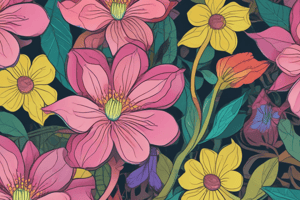Podcast
Questions and Answers
Which of the following is a primary function of petals?
Which of the following is a primary function of petals?
- Development into a fruit
- Attraction of pollinators (correct)
- Protection of the unopened flower bud
- Production of pollen
Which of the following is an example of abiotic pollination?
Which of the following is an example of abiotic pollination?
- Pollination by hummingbirds
- Pollination by bees
- Pollination by butterflies
- Pollination by wind (correct)
What is the function of the endosperm in a seed?
What is the function of the endosperm in a seed?
- Storage of food reserves (correct)
- Attracting pollinators
- Dispersal of the seed
- Protection of the embryo
Which of the following is a characteristic of a dehiscent fruit?
Which of the following is a characteristic of a dehiscent fruit?
Which of the following is NOT a seed dispersal mechanism?
Which of the following is NOT a seed dispersal mechanism?
Which of the following structures is NOT involved in pollination?
Which of the following structures is NOT involved in pollination?
Which of the following is a characteristic of double fertilization in angiosperms?
Which of the following is a characteristic of double fertilization in angiosperms?
What is the role of cotyledons in seed germination?
What is the role of cotyledons in seed germination?
Flashcards
Flower Structure
Flower Structure
Flowers are reproductive structures of angiosperms with four whorls: sepals, petals, stamens, and carpels.
Pollination
Pollination
The transfer of pollen from anther to stigma, enabling fertilization.
Types of Pollination
Types of Pollination
Pollination can be abiotic (wind, water) or biotic (insects, birds).
Double Fertilization
Double Fertilization
Signup and view all the flashcards
Seed Development
Seed Development
Signup and view all the flashcards
Fruit Types
Fruit Types
Signup and view all the flashcards
Seed Dispersal
Seed Dispersal
Signup and view all the flashcards
Germination
Germination
Signup and view all the flashcards
Study Notes
Flower Structure and Function
- Flowers are the reproductive structures of flowering plants (angiosperms).
- Flowers typically consist of four whorls of modified leaves: sepals, petals, stamens, and carpels.
- Sepals protect the unopened flower bud.
- Petals attract pollinators with their colors and fragrances.
- Stamens are the male reproductive parts, consisting of a filament supporting an anther containing pollen.
- Carpels are the female reproductive parts, comprising an ovary containing ovules, a style leading to a stigma where pollen lands.
- Pollination is the transfer of pollen from the anther to the stigma.
Types of Pollination
- Pollination can be abiotic (wind or water) or biotic (insects, birds, bats, etc.).
- Wind pollination is common in grasses and trees. Small, lightweight pollen is easily dispersed by wind.
- Water pollination is rare, but found in some aquatic plants.
- Biotic pollination often involves specialized adaptations. Flowers attract specific pollinators with color, shape, scent, and nectar.
Double Fertilization
- Double fertilization is a unique feature of angiosperms.
- One sperm cell fertilizes the egg, forming a zygote that develops into an embryo.
- The other sperm cell fuses with two polar nuclei, forming the endosperm—a nutritive tissue.
Seed Development
- The ovule develops into a seed, containing the embryo, endosperm (some seeds have no endosperm), and seed coat.
- The ovary develops into a fruit, which protects and disperses the seeds.
Fruit Development and Types
- Fruits are derived from the ovary and surrounding tissues.
- Fruits can be fleshy or dry, dehiscent (splitting open) or indehiscent (not splitting open).
- Different fruit types reflect the variations in reproductive adaptations. Examples include berries, drupes, legumes, and capsules.
Seed Dispersal
- Seed dispersal mechanisms ensure the offspring are not directly competing with the parent plant for resources.
- Seeds are dispersed by various means: wind, water, animals (ingested or attached to fur), and ballistic methods.
- Adaptations include winged seeds, buoyant seeds, and fleshy fruit. Animals often are attracted and will eat the fruits, then dispose of the seeds at some distance from the parent plant.
Germination
- Germination is the resumption of growth in a seed following a period of dormancy.
- The embryo utilizes stored food reserves (endosperm or cotyledons) to initiate growth.
- Germination requires favourable conditions like adequate moisture, temperature, and oxygen.
Variations in Floral Structures
- Floral structures are variable depending on the plant species and pollination strategy.
- Flowers can be radially symmetric (actinomorphic) or bilaterally symmetric (zygomorphic).
- Flowers can be complete (possessing all four whorls) or incomplete (lacking one or more whorls).
- Modification in flower structure reflects the adaptations to attract specific pollinators.
Studying That Suits You
Use AI to generate personalized quizzes and flashcards to suit your learning preferences.




